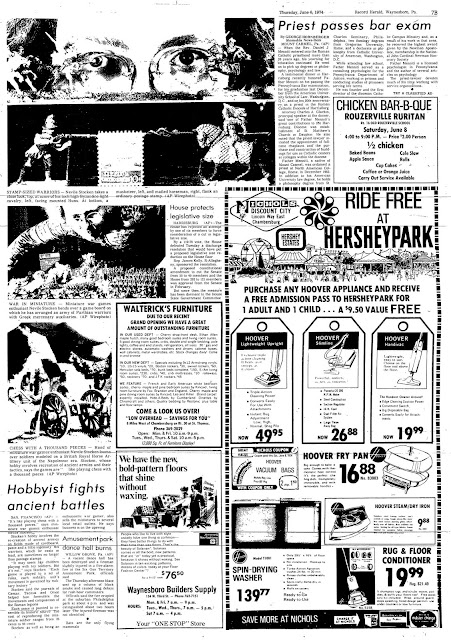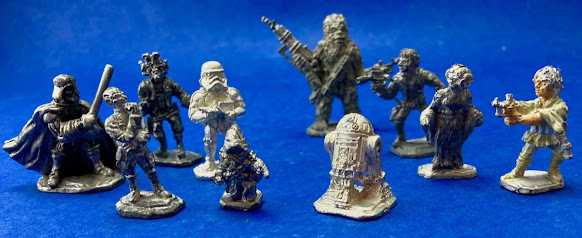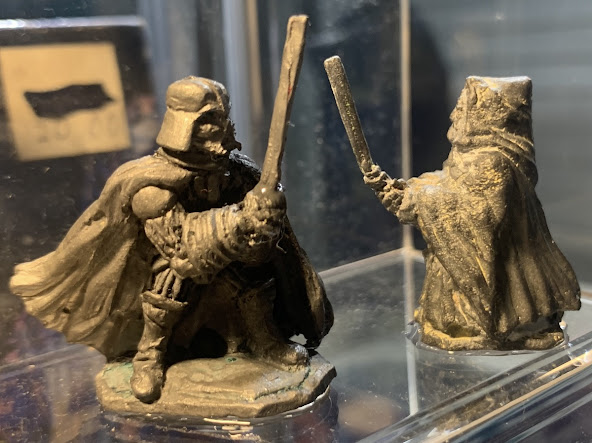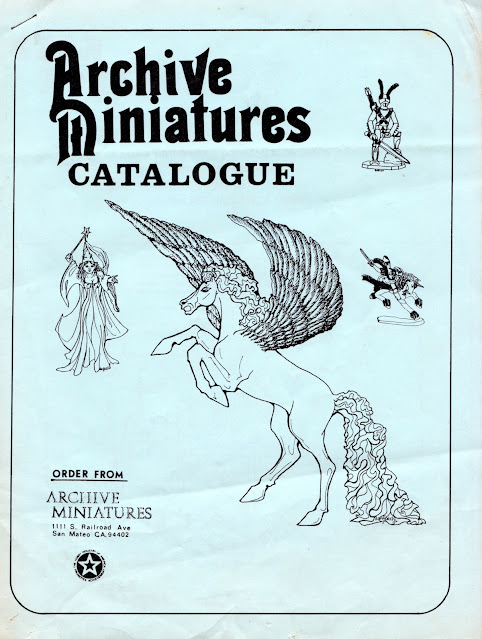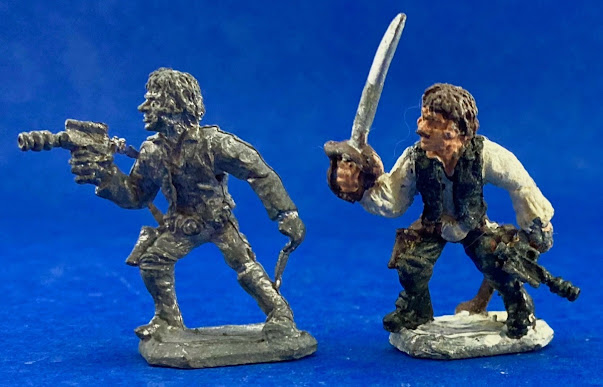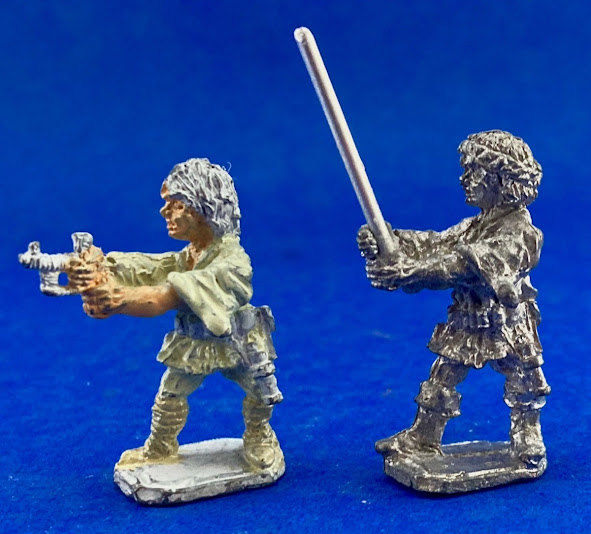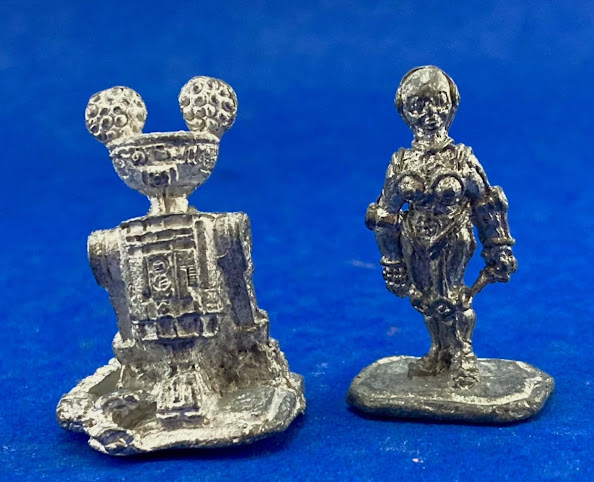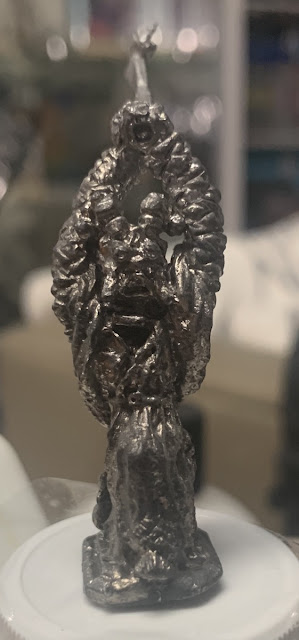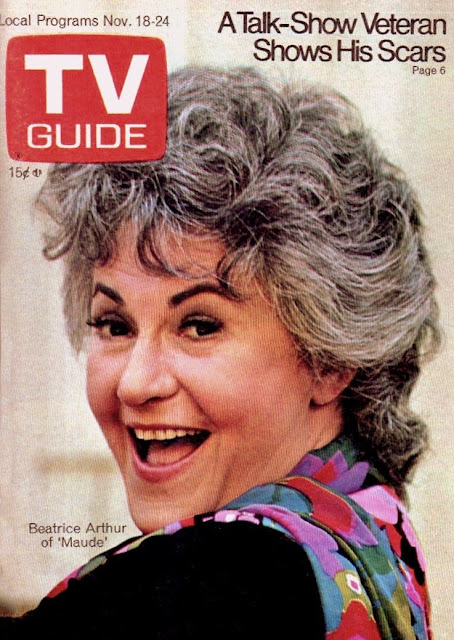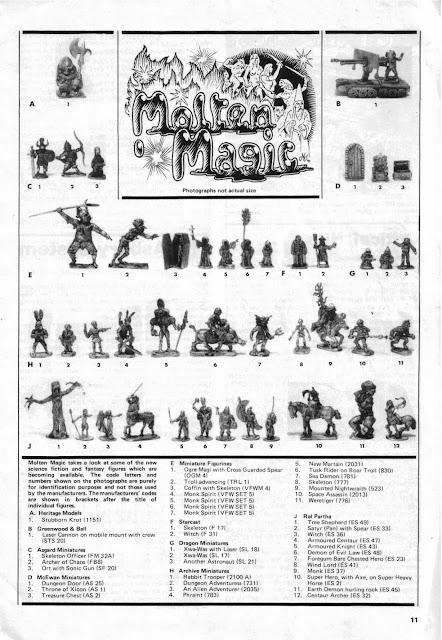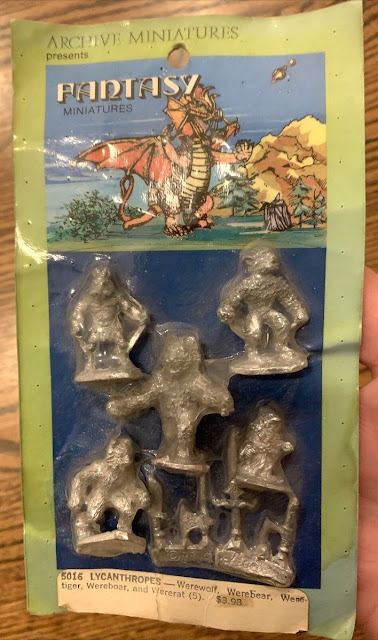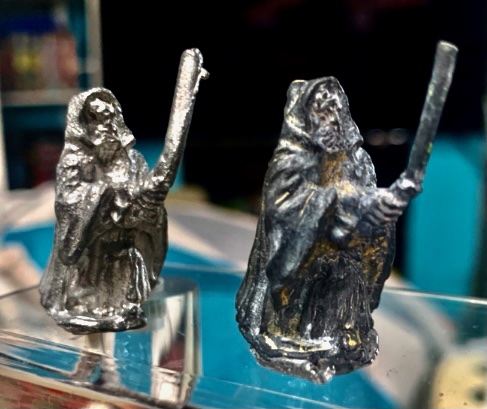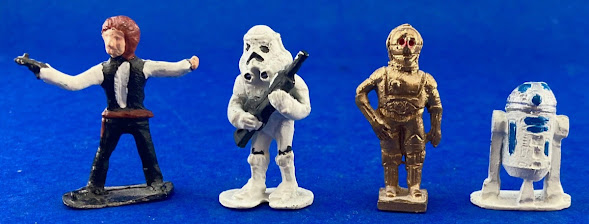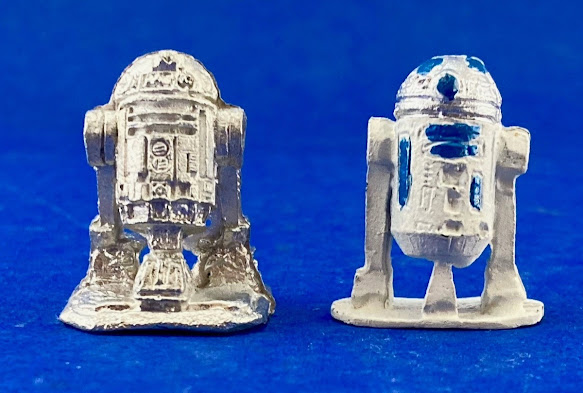Join Skye, Steve, Ron and Yehuda as they discuss the wonderful world of early, unlicensed miniatures. For highly recommended further reading, be sure to check out Ron and Yehuda's definitive original blog post on Nevile Stocken's metal miniature Star Wars figures.
Thursday, March 31, 2022
'Chive Cast Blog Log Pod Episode 18 - All About Unlicensed Archive Miniatures
Join Skye, Steve, Ron and Yehuda as they discuss the wonderful world of early, unlicensed miniatures. For highly recommended further reading, be sure to check out Ron and Yehuda's definitive original blog post on Nevile Stocken's metal miniature Star Wars figures.
Thursday, March 17, 2022
Adventures in Miniature: Nevile Stocken's Star Wars Figures (and Their Motley Offspring)
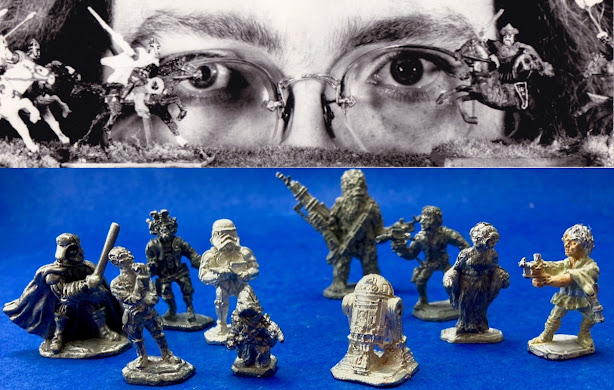
Ron (with Yehuda riding shotgun) writes:
Preface
This article is the product of many years of research and collecting adventuring with my dear friend Yehuda Kleinman, who should be regarded as a coauthor.
Collecting often reminds me of a picaresque exploit: You never know what roads the hunt will lead you down, or what strange discoveries await you at the end of those roads. But if you have a good friend at your side, you'll never be disappointed with either your discoveries or your destination.
* * *
Intro: Correcting the Record
I've written a lot about collectibles over the past 25 years. And when you write a lot about collectibles, you inevitably coin a few bits of terminology. This is both a blessing and a curse. A blessing because it's always satisfying to discover a term you invented nestled within the nerd lingua franca. A curse because some of the terms I've invented are pretty bad. And when I hear a bad one, I can't help but cringe -- because I realize I've played a part in promoting foolishness.
"Internal first shot" is surely the best example. That's a term that is justifiable colloquially but not technically. Tossing it around with friends is one thing, employing it in a reference article quite another. I should never have used it publicly. (By the way, "protomold" is the more correct term.)
Despite my regrets, I've accepted that we are stuck with "internal first shot" forever. It is never going away, no matter how hard I cringe. And that's the troubling thing about bad terms: Once people start using them, they tend not to stop. They use them in conversation, inspiring others to use them, and thereby initiating an error cascade that keeps cascading for years.
Among my worst terminology sins is the attribution of a line of miniature metal figures to a company called Heritage.
Here's the frustrating thing: I knew the figures traced back to a mail-order company called Star Trek Galore. But then someone persuaded me they were actually made by Heritage, and merely sold through Star Trek Galore.
That's what I went with, and I was wrong.
For a long time I was convinced I was solely responsible for this crime, which I perpetuated on the early internet via the Star Wars Collectors Archive. So I was a little relieved to discover that I wasn't the first somewhat authoritative source to attribute to Heritage figures that had nothing to do with Heritage.
The above price guide, published in 1985, also makes the Heritage attribution. Over 12 years before I did!
The guide clearly mentions the connection to Heritage.
Though the publication lists only nine figures, the set actually consisted of 15 unique pieces -- as we'll discuss later.
Heritage was a legitimate company, and they did make miniatures.
According to Shannon Appelcline, whose 2013 Designers & Dragons is a great source on the history of fantasy gaming, Heritage was among the first miniature companies to go heavily into licensing. They produced miniatures based on Bakshi's animated Lord of the Rings as well as Burroughs' John Carter.
On a mission to impress Lucasfilm, and thereby win a license, the company even produced sample Star Wars figures. Or so Appelcline claims in his book. Those would certainly be fun to see!
And, yes, Heritage did Star Trek, too. But not just samples -- actual licensed product.
I have to assume that Heritage's Star Trek license, a product of which you see above, fostered confusion among collectors who have trouble telling a phaser from a laser. And that that confusion spilled over to the editors of the 1985 guide, who, as I did years later, unknowingly perpetuated a misunderstanding.
Hey, it happens. Misunderstandings are like landfills: If you don't contribute to one at some point in your life, you're not living.
So now, in 2022, please allow Yehuda and me to correct the record: Aside from the speculated sample figures mentioned above, Heritage had nothing to do with miniature Star Wars figures, whether licensed or not. [1] And they certainly had nothing to do with the figures discussed in this article.
The actual history of these figures is much weirder, and more delightful, than most have supposed.
* * *
Nevile Stocken: The Man Behind the Minis
Stocken's hobby involves the re-creation of ancient armies on fields made of cardboard, paste and a little ingenuity. His warriors, which he casts in lead, are sometimes no larger than postage stamps . . . Each piece is painted to resemble its historic source. The cost of reproducing the miniature soldiers ranges from 25 cents to 90 cents. Stocken, as well as being an enthusiastic war gamer, also sells the miniatures to several local retail outlets. He says business is on the upswing. [2]
Stocken, aided by his wife Barbara, was the driving force behind Archive Miniatures (no connection to this blog). Founded in 1973 and headquartered in Burlingame, California, Archive was among the first companies to specialize in metal miniatures intended for use in war and role-play gaming. Naturally, Stocken was the outfit's chief sculptor.
Popular from the first, Archive's figures were appreciated for their stoutness and detail, and for their ability to capture the essence of the represented characters through pose, costume, and facial expression. Among their early offerings were figures based on The Lord of the Rings as well as fantasy properties like White Bear and Red Moon.
The '70s were a wild era for gaming. TSR kicked the whole thing off in 1974 with their publication of Dungeon & Dragons, and by the following year they'd incorporated metal miniatures into the game's play pattern. Immediately, gamers became hungry for the small accessories, which added visual and tactile interest to the largely mental process of gaming. As more properties were translated into games, and gamers got more creative with their invented scenarios, a greater variety of figures was demanded. Personalities drawn from classic cinema and literature, ghouls like Count Dracula and Frankenstein's monster, and of course Tolkien's menagerie of Middle Earth entities jockeyed for space with the novel inventions of a bevy of popular sculptors.
 |
| The Stockens at the 1980 Origins con |
In Star Wars Stocken found a new source of inspiration. The movie was filled with wild creatures and vivid characters -- many of them perfect for miniatures.
"Star Wars just grabbed a hold of me," Stocken told the San Rafael Independent Journal, "and I started turning [figures] out."
In all, Stocken is known to have sculpted 26 figures for Archive's Star Wars line. You see 10 of them in the above photo.
Above you see some additional characters that Kenner neglected, namely the band from the famous Tatooine Cantina, an alien from the same venue, and the spy who reported the location of the Millennium Falcon to the Imperials at Mos Eisley.
Here's a page from the October 11, 1977 edition of the San Rafael Independent Journal (already quoted above). Its "Overlook" column includes a very interesting item under the heading "Itsy bitsy wookies."
Apparently, after being unable to get in touch with Lucasfilm, Stocken attempted to contact George Lucas directly, through the intermediary of his local newspaper.
Now, to be fair, in 1977 Lucasfilm was probably inundated with offers to produce Star Wars merchandise. They couldn't be expected to respond to every single inquiry.
Regardless, Kenner already had the toy license, and I think we can be sure that their response to an offer to share its rewards with a small-time manufacturer of gaming miniatures would probably be something along the lines of "fat chance."
In fact, come 1982, Kenner produced its own line of metal miniatures, called the Micro Collection. As for legit Star Wars gaming miniatures, they weren't produced until the late '80s, when West End Games acquired a license.
Bootleg Star Wars merchandise was a hot topic in the summer of 1977, as this item from the Bucks County Courier Times of July 6, 1977 shows. Though the article doesn't mention Kenner or miniature figures, I wouldn't be surprised if Stocken's productions were caught up in a sweep related to the one it details.
By the way, note that Star Trek Galore is referenced in the text. We've mentioned them before, and they'll appear again later in our narrative. Just hang tight.
Whatever the specifics, Archive Miniatures appears to have been hit with a Lucasfilm cease and desist letter soon after Stocken's figures were made available. At that point, as he was quoted by David Wood of Dear Tony Blair, "the brickbats began flying, and history would prove that the stunt was a grave error of judgement on my part."
Despite the resulting legal scare, Stocken remained positive about his involvement with Star Wars, choosing to emphasize the joy it brought him rather than the grief:
But do I regret making them? Never! Sculpting them was one of my greatest joys, and they were some of my best work. Indeed, watching multitudes of people spontaneously and almost compulsively break out in whistling and humming the cantina music as soon as they laid eyes on the painted examples of the Cantina Band displayed on the table made the grief I subsequently endured almost worthwhile. If I had to do it all over again, I would have made them again in a heartbeat, but I would have handled their presentation to the world in a much wiser fashion than I did.So cuff me and stuff me, I am guilty. But I will go to my grave remembering with relish every stroke of the sculpting knives I made upon the clay in their making.
Below is a list of the Star Wars figures that we believe were produced by Archive Miniatures. The rarest of these seem to be Aunt Beru and Tarkin.
Weirdly, it appears that no C-3PO figure was produced. Or at least I haven't seen evidence of one.
There may be other figures out there. Given the handmade nature of these and the inconsistent manner of their distribution, anything is possible. [3]
Anyway, though we don't have the precise date, I think we can be confident that, by early 1978, Archive had mostly stopped producing their Star Wars line under threat of legal action.
But, as we'll see, that wasn't the end of the story.
* * *
Star Rovers: Parody Loves Company
I have to be honest, I don't know what I mean by "parody loves company." I just like the ring of it.
It sounds like the title of an '80s comedy about Dudley Moore and a little person who looks just like him.
I can hear the trailer now:
If you love LAUGHS
If you love LOVE.
SEE Parody Loves Company.
With Dudley Moore. And Dudley Less.
Wait . . . did I just unthinkingly reinvent (and sort of invert) the plot of Twins?
We ended the last segment with Nevile Stocken's Archive Miniatures being threatened into ceasing production of their line of metal Star Wars miniatures.
If you're a small manufacturer of gaming wares, how do you handle such a threat? Well, the first thing you do is comply, because you don't want to go to jail or get fined into oblivion. The second thing you do is try to determine how you can get around the law.
To cut right to the chase, Archive opted to slightly modify their Star Wars figures so that they were, you know, sort of like Star Wars, but also sort of different. They also released some figures that were parodies of Star Wars characters. Parodies, of course, are protected under the law.
I'm no lawyer, and I'm not going to weigh in on the legal prudence of Archive's strategy, but they appear to have gotten away with it: As far as I know, the second wave of Archive Star Wars product was available into the early '80s.
Actually, Star Wars is technically incorrect; the line in which the Star Wars parodies were inserted was called Star Rovers. That's an advertisement for it that you see above.
Star Rovers was a role-playing game that was initially developed by gaming guru David A. Hargrave. But by 1978 Stocken had taken over as lead developer. And thus it was that Star Rovers came to incorporate a bit of Star Wars.
For years Yehuda and I remained confused as to how the modified and parody figures related to Stocken's original Star Wars pieces. It wasn't until we saw some packaged examples in the collection of our friend Jeff Correll that we realized they were part of a distinct line called Star Rovers.
Our understanding was greatly enlarged upon my acquiring an old Archive Miniatures catalog. It helpfully provides the names of all of the figures in the Star Rovers line along with their stock numbers.
 |
| Figures with a connection to Star Wars marked with a red "x" |
If I harp too incessantly on the importance of original advertisements and catalogs it's only because I think collectors pay them too little attention. Often, these are the only pieces of documentation that can fully inform our understanding of products that have been unavailable for years or even decades. Memories and the happenstance of extant examples can never provide the certainty offered by original documentation deriving from the source company.
That said, there is some wonkiness evident in the list provided by the catalog. For example, the Jawas, a.k.a. Desert Sand Rats (#2076), are not present; it's possible they were dropped from the line at a point in time prior to the publication of the catalog. Additionally, the Tusken Raiders, a.k.a. Sand Devils, are listed under two different stock numbers, #2096 and #2097. Sets containing both or either of the two different standing Sand Devil figures (one with gaffi, another with rifle) are known to exist under the two different stock numbers.
Not all of Stocken's Star Wars figures were reworked into Star Rovers. The figures that never made it into the later line are:
- Aunt Beru
- Grand Moff Tarkin
- Princess Leia
- Darth Vader (in a form deriving from the original)
And is the figure on the right Han Solo or some kind of buccaneer? The catalog refers to him as the Pirate Captain, so I guess it's the latter! The Pirate Captain's pants were baggier than Han Solo's; he also wore a scabbard -- for his sword, of course. The sword and blaster were separate pieces that were intended to be glued into the figure's hands.
As for Luke, now called Disciple, he was given a crown of laurel leaves and a removable lightsaber in place of his integrated blaster. In fact, the figure came packaged with both a saber and a blaster; so a purchaser had some options. As you may have noticed, the boots were changed between the two iterations of the figure.
Obi-Wan, on the other hand, remained mostly unchanged, the only notable difference being that his lightsaber was now a removable piece rather than integrated into the hands of the figure. Wait, did I call him Obi-Wan? In the Star Rovers universe, his name was Star Knight of the Quasar.
Stocken's original Star Wars line included two Stormtroopers: one with arms raised and one with arms at chest height. Both of these were reworked into Star Rovers by enlarging their helmets and adding circular elements to their foreheads and chests. Star Rovers titles: Imperial Marine Trooper (arms at chest) and Imperial Marine NCO (arms raised).
In the translation from Star Wars to Star Rovers, perhaps no figure from Stocken's original line was treated more unusually than R2-D2. Not only was the droid given a tail, his dome was inverted and decorated with protrusions resembling Mickey Mouse ears. New name: R2-T2. [4]
As for C-3PO, who was not present in the original Star Wars line, Star Rovers included a reasonable replacement in the form of a figure resembling the Maria simulacrum from Fritz Lang's Metropolis. The figure was called Rsla Androidess, presumably in homage to Bond beauty Ursula Andress.
As I mentioned earlier, the Darth Vader figure from Stocken's original Star Wars line did not appear in Star Rovers. Perhaps because the stature of the original figure was rather unimpressive (it was about the same size as Obi-Wan), Stocken created a new figure, dubbing him Thvar Dread, Star Knight of the Nova. Not only was the new figure larger, it had horns and a flared samurai-style helmet. Like his mortal enemy the Star Knight of the Quasar (Obi-Wan), the figure's saber was a separate piece.
The figure on the right of the above photo demonstrates a key aspect of Star Rovers: Because the figures' odd horns, ears, and protrusions could be clipped or ground off by the consumer, it was possible to customize them into rough likenesses of their Star Wars counterparts. Thus Stocken and Archive Miniatures both avoided strict infringement and allowed their customers to -- with a little trouble -- obtain figures that scratched their Star Wars itch.
Betcha didn't know that in the Star Rovers universe the Tusken Raiders had horns. Well, they weren't really Tusken Raiders; they were Sand Devils. So maybe it makes total sense that they had horns. The gaffi stick of the above-pictured figure was packaged as a separate part.
The rifle of the other Sand Devil, however, was integrated into the figure's hands. As was done in the case of Chewbacca, the Sand Devils' weapons were bulked out a bit when translating the figures to Star Rovers, presumably to prevent breakage.
Of course, Stocken's favorite, the Cantina band, made an appearance in Star Rovers, complete with all five players. But now its members sported funny little antennae. The band's moniker in the Star Rovers universe was Moondog Maud's Cantina Band.
But who was Maud?
I have to be honest: At first I thought the name was a reference to Bea Arthur.
Recall that in the infamous Star Wars Holiday Special our dear Aunt Bea played the proprietor of the Cantina, a venue at which the Band seemed a regular feature. Well, those of you old enough to remember the '70s may be aware that she also played Maude on the eponymous TV show.
So, naturally, I assumed the name of the Star Rovers Cantina Band was the result of some seriously deep pop-cultural-referencing jujitsu on the part of Stocken.
Bea Arthur played Maude, and there she was in the Holiday Special overseeing the Cantina. It was Maude's joint!
I was wrong.
According to Stocken, as quoted at Dear Tony Blair, the name was actually an homage to a lesbian bar adjacent to the sculptor's former apartment in San Francisco. Of course, the bar was named Maud's.
Hey, if in the Star Rovers universe these musicians were the house band at a lesbian bar, do you suppose they were female? Maybe females of this particular musician race have antennae? Someone get me Wookieepedia on the phone, because their canon is all wrong.
Wikipedia has a good write-up on Maud's, which operated from 1966 until 1989. There's even a documentary film devoted to the bar. You can watch a clip of it here. Try not to hum the Catina theme music while doing so.
Moondog Maud's Cantina Band and the Star Wizard/Disciple pair were also featured in the February 1979 issue of Craft, Hobby & Model Industry.
Of the figures featured on the above magazine pages, Yehuda and I lack photos of a loose Star Rovers Bantha, whose name in the Star Rovers universe was War Buffalope. (You can see a photo here.) It differed from the Bantha in that it had a horn protruding from its forehead. Two distinct Buffalopes were included in Star Rovers, one with a saddle that came packaged with two Sand Devil riders, and one without a saddle. The riders had horns, just like the standing Sand Devils.
Greedo, who in Star Rovers was called Kroll Bounty Hunter, and the chess creature with club, a.k.a. rockhopper (a photo can be seen here), remained basically unchanged from their original Star Wars incarnations.
I guess not everything is awry in the Star Rovers universe!
Well, in the Star Rovers universe these two were married, or at least regularly getting it on, because they were packaged together in a set called Alien Family along with a baby that appears to be a hybrid of their respective species.
The March 1979 issue of Craft, Hobby & Model Industry featured the Pirate Captain and Bounty Hunter as well as two Jawas, who in the Star Rovers universe were known, somewhat derogatorily, as Desert Sand Rats.
Whereas the original Jawa, seen on the left of the above photo, had a small base, the bases of its Star Rovers counterparts were extended considerably.
Why? To accommodate their coiled tails, of course!
One Desert Sand Rat was posed nearly identically to the Jawa; the other held a blaster.
Lastly, and possibly leastly if we judge the group by the stature of the larger portion of them, was the Star Fellowship.
What, you ask, was the Star Fellowship?
They were a group of seven figures that mashed up Star Wars and Lord of the Rings -- one of the few mergers of the two properties that I am aware of.
Nicknamed the Star Warps by gamers, the group consisted of:
- Hans Self, a Soloesque hero.
- RT-2T (already mentioned above).
- Rsla Androidess (already mentioned above).
- Leke Skyhibbit, a figure resembling a Hobbit that appears to be unrelated to Luke Skywalker in all details but name.
- Princess Luia, basically a Hobbit Princess Leia.
- Obi Tu, a Hobbit Obi-Wan (see photo here).
- The fabulously named Chewgumma the Fuzzy, the Emmanuel Lewis of Wookiees.
Here's yet another ad, this one featuring somewhat reduced prices.
So what was going on here?
It appears that STG, or one of their suppliers, purchased a selection of Stocken's figures (or copies of them), used them to make molds, and then cast their own line of metal miniatures.
That's a full set of these figures, most of them bootlegs of bootlegs, that you see in the above photo. A set consisted of one of each unique figure and two additional Jawas. [10]
As the ads make clear, these figures were available painted, unpainted, or plated in either gold or nickel. You can get a sense of the visual presented by each finish by referring to the above photo. Personally, I've always preferred the painted versions, perhaps because the paint obscures the crummy molding quality.
I think "crummy" is the right word: Due in part of loss of fidelity resulting from second- or third-generation molds, the STG figures lacked the detail and finish of Stocken's products. Unsightly mold lines and blown-out details abounded. This is perhaps best evidenced by the STG Vader and Ob-Wan figures, which appear to be holding curved clubs rather than lightsabers. See the example on the left of the above photo.
Speaking of crummy, you're probably looking at that nickel-plated Stormtrooper and thinking, "Gee, that doesn't look like Stocken's work -- or even a clumsy copy of his work."
You are correct. Of the 15 distinct figures in the STG set, four did not derive from Archive Miniatures but rather from unique sculpts done by someone who was not as talented as Nevile Stocken.
I call them the Fugly Four.
They were, by any measure of aesthetic merit, terrible. My favorite is Han Solo, who looks like Michael Cera cosplaying as Cornelius from Planet of the Apes.
But R2-D2 is also pretty bad, and compares unfavorably with Stocken's very movie-authentic original.
These new sculpts were much more refined than their predecessors. Their casting quality also tended to be significantly better.
This alternate R2-D2 (right) lacks a base. As it's the only one we've seen, we're not sure if that was normal or this example was modified in some way.
Resculpting wasn't limited to the Fugly Four: the STG Leia figure also appears to have been modified at some point in time. The modified figure, shown above in gold, was slighter of frame than its predecessor (second from left); however, it retained the basic look of Stocken's original, which is seen at left.
By the way, the figure on the right is Archive's Dungeon Adventuress. It bears an undeniable similarity to Stocken's Leia. It may be that Stocken reworked the Leia into the Dungeon Adventuress. (See Note 3 below.)
All of the modified STG figures are substantially rarer than their first-release STG counterparts.
STG didn't stop with figures; as the above ad shows, they also adapted both Stocken's and their modified figures into jewelry and keychains.
The ad is amusing in that it positions bootleg jewelry beside licensed examples produced by Factors subsidiary Weingeroff. And in some cases the bootlegs are pricier than the official merch!
Like I said earlier, you have to marvel at the audaciousness.
The above-pictured necklaces featuring R2-D2, C-3PO, and the Jawa were available beside more expensive necklaces bearing painted versions of STG's Stormtrooper, Chewbacca, Vader, and Obi-Wan. None of these figures had bases. Note that the C-3PO and R2-D2 necklaces make use of the modified versions of those figures.
The Jawa was available in either gold or nickel, whereas R2 was available in nickel only. As for C-3PO, he was, naturally, available solely in gold.
If you're muttering to yourself, "Dang, that's nuts, I'll never find all of these stupid things!" well, don't expect me to disagree with you.
Because it is indeed pretty nuts. And pretty stupid.
Didn't I warn you at the end of the last section that things were about to get weird?
 |
| This ad suggests that someone made the STG set available to Japanese customers |
By the way, how are you?
Still with me, cowboy? Still driving our doggies along the high lonesome trail?
We're almost done, I promise. We just have one last piece of the puzzle to place, at which point we should be able to offer a more or less complete picture.
In doing so we'll present a potential solution to a mystery that has bewildered collectors for years.
* * *
The Mystery of the Blue Box
As the ad has doubtlessly informed you, the box contains . . . yes, more crummy copies of Nevile Stocken's Star Wars figures.
That much has always been clear.
But it's remained a matter of speculation as to how these figures might relate to the Star Trek Galore set. Do they constitute an alternate STG set or something else?
Some thought the blue box might be a one-off thing, that some industrious collector had simply created it to house his personal set of STG figures. But that theory didn't explain the extra Bantha (the STG set, remember, included only one) or the lack of the Fugly Four. And as more blue boxes surfaced, it became apparent that they were sold in some quantity.
Earlier in this (egregiously long) article, I extolled the benefits to the collector of original catalogs and advertising. Without these aids, it's often impossible to determine what is out there, or at least was out there. Sure, it sometimes happens that an item is advertised but not sold; but these instances are rare and usually easily identified. Generally speaking, if you want to know what items in a particular production range were available, you need to go back to the original source: the publications that retailers and consumers used to order them.
Keeping that sentiment in mind, you can probably imagine how chuffed Yehuda and I were upon discovering the above advertisement. It shows the 12 figures contained by the blue box, including the saddleless Bantha. Although it doesn't bear a date, the content of the catalog from which it derives leads me to believe it was released in 1978.
The ad is a product of an outfit called Pose Posters. Based in Los Angeles, but apparently run via mail-order, Pose specialized in music ephemera, Elvis stuff in particular.
Like, if you were living in the late '70s, and you really wanted to buy some tasteless Elvis crap, Pose Posters was your source.
By the way, have you noticed that no one cares about Elvis these days?
When I was a kid, Elvis was a real thing -- as the inventory of Pose Posters attests.
These days, most of the folks who bought Elvis plates and mugs and latch hook rugs are dead, their Elvis mementos exiled to the sun-faded tables of weedy outdoor flea markets. Like the half-sunk shattered visage of that poem about an entirely different king, they've been divested of all glamour but that which attends reflections upon abandonment, decay, and impermanence.
Collectors, let this be a lesson to you: Worldly influence is fleeting. Even your precious 12-backs will one day be trash.
Anyway, though the Pose Posters ad cleared things up substantially, it frustrated us because it didn't promote the 12 figures as a set.
As far as I know, all of the blue boxes that have surfaced contained all of the figures in the Pose ad. Presumably, you got the box when you ordered all of them together.
Fortunately, we located an additional Pose Posters advertisement. This one does advertise the figures as a set. You could purchase them all for $69 plus $3 postage.
$69 in 1978 dollars is like $300 in 2022 dollars, and (the way things are going) probably $2,000 in projected 2023 dollars.
You may recall that Star Trek Galore offered unpainted sets for a mere $25. And that was with additional figures! What gives with the price discrepancy?
I think it may have something to do with the figures in the Pose set allegedly being cast in "solid pewter," whereas the STG figures were advertised as being cast in a mere "pewter-type metal."
I write "allegedly" because I'm not at all confident that Pose Posters was being entirely honest here. I mean, it's not like there was a regulatory body policing the claims of dodgy sellers of Elvis crap.
Solidly pewter or not, the figures in the Pose set do look duller and I suppose more pewter-like than those in the STG set. That's the Pose Luke you see on the left in the above photo.
You have no doubt noticed that the Pose set lacks the figures that in the STG set comprise the Fugly Four. What do you suppose was going on there?
I suspect one of two following scenarios prevailed:
- The STG set was copied from the Pose set. The copier, upon realizing that potential purchasers would miss characters like Han, C-3PO, Stormtrooper, and R2-D2 (none of them present in the Pose set), created the Fugly Four to rectify their absence. He also dropped the saddleless Bantha because . . . well, one Bantha is really quite enough, thank you very much.
- The STG and Pose sets were made by the same person. However, he added the Fugly Four to the STG set and dropped the Bantha for reasons of which we remain ignorant.
In any event, whoever was behind these figures appears to have lacked access to Stocken's excellent figures representing Han Solo, Stormtrooper, and R2-D2. And it surely isn't a coincidence that the Pose set is missing precisely those figures that were specially sculpted for the STG set. There would appear to be some connection here.
You'll be relieved to know that the Pose set is substantially tidier than the sets we discussed previously. A mere 12 figures! And no variations worth mentioning.
* * *
Outro: Signed Nevile Stocken
Yehuda and I hope you've enjoyed this demystification of a range of collectibles that has been misunderstood by Star Wars collectors for decades. It's been a pleasure writing it in part because it's given me a chance to reflect on my friendship with Yehuda and the fun we've had pursuing these figures.
- The figure picture beside the Rabbit Trooper, the Dungeon Adventuress, is very similar in some respects to Stocken's Princess Leia. I believe the figure was part of Archive's Dungeon Adventure series (see photo above).
- The Jawas, identified by the label "G," were part of a small Star Wars-inspired line marketed by a company called Dragon Miniatures.










